Assessing the Impacts of Changing Connectivity of Hydropower Dams on the Distribution of Fish Species in the 3S Rivers, a Tributary of the Lower Mekong
Abstract
1. Introduction
2. Materials and Methods
2.1. Data and Process
2.2. Study Area
2.3. Distribution of Hydropower Projects in 3S Basins
2.4. Connectivity of River Reaches within the 3S Basin
2.5. Distribution of Fish Species
2.6. Impact of Reservoirs on Species Distribution
- Calculating the proportion of the lengths all the river reach classes with high gradients in each Level 8 HydroBasin—codes 33102, 33302, 43102, 43302, 44102, 48300, 53300 and 58300. The full list of the river reach classes in the 3S is found in Supplementary Material Table S6.
- Calculating the proportion of the area of each Level 8 HydroBasin which has been or will be inundated by hydropower reservoirs.
- Multiplying these two proportions together to obtain an estimate of the percentage of the river reach classes that will be inundated in each Level 8 HydroBasin.
- Multiplying the percentage of inundated, high-gradient river reaches by the number of rithron-resident species represented in each Level 8 HydroBasin. The resulting values are then normalised to show very high to very low risks to rithron-resident species in each HydroBasin.
3. Results
3.1. Existing and Proposed Hydropower Projects in 3S Basin
3.2. Mapping the Connectivity of the River Reaches with Existing and Future HPPs
3.3. Confirmation of the Global Red List Fish Species Distribution by HydroBasin
3.4. Distribution of Migratory, Threatened and Endemic Species on the 3S River Sub-Catchments
3.5. Changes in Migratory Fish Populations by the Barrier Effects of Dams
4. Discussion
5. Conclusions
Supplementary Materials
Author Contributions
Funding
Data Availability Statement
Acknowledgments
Conflicts of Interest
References
- Chowdhury, K.A.F.M.; Wild, T.; Zhang, Y.; Binsted, M.; Iyer, G.; Kim, S.H.; Lamontagne, J. Hydropower expansion in eco-sensitive river basins under global energy-economic change. Nat. Sustain. 2024, 7, 213–222. [Google Scholar] [CrossRef]
- Eyler, B.; Kwan, R.; Basist, A.; Weatherby, C. Analysis of Hydropower Impacts in the Mekong’s 3S Basin—A Technical Report Using Mekong Dam Monitor Observations and MRC Data to Show How 20 Dams are Changing the Hydrological Flow of the 3S Basin and the Mekong River at large; Stimson Centre: Washington, DC, USA, 2023; Available online: https://www.stimson.org/2023/analysis-of-hydropower-impacts-in-the-mekongs-3s-basin/ (accessed on 10 February 2024).
- Baird, I.G.; Thorne, M.A.S. The downstream impacts of dams on the seasonally flooded riverine forests of the Mekong River in northeastern Cambodia. South-East Asia Res. 2023, 31, 377–399. [Google Scholar] [CrossRef]
- Dugan, P.J.; Barlow, C.; Agostinho, A.A.; Baran, E.; Cada, G.F.; Chen, D.; Cowx, I.G.; Ferguson, J.W.; Jutagate, T.; Mallen-Cooper, M.; et al. Fish Migration, Dams, and Loss of Ecosystem Services in the Mekong Basin. AMBIO 2010, 39, 344–348. [Google Scholar] [CrossRef]
- Soukhaphon, A.; Baird, I.G.; Hogan, Z.S. The Impacts of Hydropower Dams in the Mekong River Basin: A Review. Water 2021, 13, 265. [Google Scholar] [CrossRef]
- CEPF. Ecosystem Profile—Indo-Burma Biodiversity Hotspot—2020 Update; Critical Ecosystem Partnership Fund: Arlington, VA, USA, 2020. [Google Scholar]
- MRC, M.R.C. Basin-Wide Assessment of Climate Change Impacts on Hydropower Production. Final Report; Mekong River Commission: Vientiane, Laos, 2018. [Google Scholar]
- Lowgren, S. Mekong River at Its Lowest in 100 Years, Threatening Food Supply, in National Geographic. 2019. Available online: https://www.nationalgeographic.com/environment/2019/07/mekong-river-lowestlevels-100-years-food-shortages/ (accessed on 2 April 2024).
- Fancourt, M.; Walker, S.; Sassen, M. Commodities and Biodiversity in the Greater Mekong—Impacts of Commodity Development on Biodiversity and Ecosystem Services in the Greater Mekong and Its Headwaters; UNEP World Conservation Monitoring Centre: Cambridge, UK, 2015. [Google Scholar]
- Thomas, G.A.; Annandale, G.; Bouapao, L.; Hortle, K.G.; Jensen, E.D.; Kaini, P. Sustainable Hydropower Master Plan for Xe Kong Basin in Lao PDR. Thomas, G., Ed.; Natural Heritage Institute: Vientiane, Laos, 2018. [Google Scholar]
- Ziv, G.; Baran, E.; So Nam Rodríguez-Iturbe, I.; Levin, S. Trading-off fish biodiversity, food security, and hydropower in the Mekong River Basin. Proc. Natl. Acad. Sci. USA 2012, 109, 5609–5614. [Google Scholar] [CrossRef]
- Schmutz, S.; Moog, O. Dams: Ecological Impacts and Management, in Riverine Ecosystem Management; Schmutz, S., Sendzimir, J., Eds.; Springer: Cham, Switzerland, 2018. [Google Scholar] [CrossRef]
- Null, S.E.; Farshid, A.; Goodrum, G.; Gray, C.A.; Lohani, S.; Morrisett, C.N.; Prudencio, L.; Sor, R. A Meta-Analysis of Environmental Tradeoffs of Hydropower Dams in the Sekong, Sesan, and Srepok (3S) Rivers of the Lower Mekong Basin. Water 2021, 13, 63. [Google Scholar] [CrossRef]
- Adamson, P.T.; Rutherfurd, I.D.; Peel, M.C.; Conlan, I.A. Chapter 4—The Hydrology of the Mekong River. In The Mekong Biophysical Environment of an International River Basin; Campbell, I.C., Ed.; Aquatic Ecology; Academic Press: Cambridge, MA, USA, 2009; pp. 53–76. [Google Scholar] [CrossRef]
- Meynell, P. The Sekong River in Vietnam, Lao PDR and Cambodia. An information sourcebook for dialogue on River Flow Management; IUCN: Bangkok, Thailand, 2014; p. 139. [Google Scholar]
- CEPF. Indo-Burma Biodiversity Hot Spot—Ecosystem Profile—2011 Update; Critical Ecosystem Partnership Fund: Arlington, VA, USA, 2012. [Google Scholar]
- Kottelat, M. Fishes of the Xe Kong Drainage in Laos, Especially from the Xe Kaman; WWF: Gland, Switzerland; Critical Ecosystem Partnership Fund: Arlington, VA, USA, 2011. [Google Scholar]
- Allen, D.J.; Smith, K.G.; Darwall, W.R.T. (Eds.) The Status and Distribution of Freshwater Biodiversity in Indo-Burma; IUCN: Cambridge, UK; Gland, Switzerland, 2012; p. x+158pp+4pp cover. [Google Scholar]
- Baird, I.G. Investigations of the Xekamman and Xexou Rivers with special reference to freshwater fish and river ecology; and a review of the potential social and environmental impacts of large dam projects on these two rivers in Attapeu Province, Southern Lao PDR. In Report Prepared for the Protected Areas Division; Department of Forestry, Lao PDR: Vientiane, Laos, 1995. [Google Scholar]
- MFD. Mekong Fish Database: A Taxonomic Fish Database for the Mekong Basin CDROM; Mekong_River_Commission: Phnom Penh, Cambodia, 2003. [Google Scholar]
- Baird, I.G.; Mean, M. Sesan River Fisheries Monitoring in Ratanakiri Province, Northeast Cambodia: Before and After the Construction of the Yali Falls Dam in the Central Highlands of Viet Nam; 3S Rivers Protection Network (3SPN), the Global Association for people and the Environment(GAPE): Ban Lung, Northeast Cambodia, 2005; p. 45. [Google Scholar]
- Nguyen, H.D.; Van Thiet, T.; Van Sang, L. Fish Fauna at Chu Yang Sin National Park, Dak Lak Province; Chu Yang Sin National Park: Tây Nguyên, Vietnam, 2006; p. 17. [Google Scholar]
- Chan, S.; Solida, P.; Nam, S. Fish abundance survey and installation of fish catch monitoring system for the Srepok River. In Srepok Wilderness Area Project Technical Paper; WWF Greater Mekong—Cambodia country programme and Inland Fisheries Research and Development Institute: Phnom Penh, Cambodia, 2008; p. 37. [Google Scholar]
- Kottelat, M. Fishes of the Xe Kong drainage in Laos. In WWF Project “Aquatic Resources Management to Improve Rural Livelihoods of the Xe Kong Basin; WWF: Vientiane, Laos, 2009. [Google Scholar]
- Baran, E.; Saray, S.; Teoh, S.J.; Tran, T.C. Fish and fisheries in the Sesan, Sekong and Srepok River Basins (Mekong Watershed). In On Optimizing the Management of Cascades or System of Reservoirs at Catchment Level; ICEM: Hanoi, Vietnam, 2014. [Google Scholar]
- Baird, I.G.; Flaherty, M.S.; Phylavanh, B. Rhythms of the river: Lunar phases and migrations of small carps (Cyprinidae) in the Mekong River. Nat. Hist. Bull. Siam Soc. 2003, 51, 5–36. [Google Scholar]
- Baird, I.G. Best Practices in Compensation and Resettlement for Large Dams: The Case of the Planned Lower Sesan 2 Hydropower Project in Northeastern Cambodia; Rivers Coalition in Cambodia: Phnom Penh, Cambodia, 2009. [Google Scholar]
- Mallen-Cooper, M.; Cowx, I.; Jensen, E. Fish Passage at Lower Sesan 2 Dam: Design Principles, Preliminary Criteria and Concepts; Natural Heritage Institute: San Francisco, CA, USA, 2015. [Google Scholar]
- O’Connor, J.; Hale, R.; Mallen-Cooper, M.; Cooke, S.J.; Stuart, J. Developing performance standards in fish passage: Integrating ecology, engineering and socio-economics. Ecol. Eng. 2022, 182, 106732. [Google Scholar] [CrossRef]
- Welcomme, R.L.; Winemiller, K.O.; Cowx, I.G. Fish environmental guilds as a tool for assessment of ecological condition of rivers. River Res. Appl. 2006, 22, 377–396. [Google Scholar] [CrossRef]
- Montaña, C.G.; Ou, C.; Keppeler, F.W.; Winemiller, K.O. Functional and trophic diversity of fishes in the Mekong-3S river system: Comparison of morphological and isotopic patterns. Environ. Biol. Fishes 2020, 103, 185–200. [Google Scholar] [CrossRef]
- Welcomme, R.L.; Baird, I.G.; Dudgeon, D.; Halls, A.; Lamberts, D.; Mustafa, M.G. Fisheries of the rivers of Southeast Asia. In Freshwater Fisheries Ecology; Craig, J.E., Ed.; John Wiley & Sons Ltd.: Hoboken, NJ, USA, 2016; pp. 363–376. [Google Scholar]
- Halls, A.S.; Kshatriya, M. Modelling the cumulative barrier and passage effects of mainstream hydropower dams on migratory fish populations in the Lower Mekong Basin. In MRC Technical Paper; Mekong River Commission: Vientiane, Laos, 2009; p. 104. [Google Scholar]
- Sun, J.; Yu, F.; Zhang, Q.; Luo, S.; Zhou, W.; Zhang, H.; Tan, J.; Shi, X.; Shen, Y.; Shi, J. Evaluation of a Nature-like Bypass for Non-Salmonids in the Sesan River. Water 2023, 15, 16. [Google Scholar] [CrossRef]
- Orr, S.; Pittock, J.; Chapagain, A.; Dumaresq, D. Dams on the Mekong River: Lost fish protein and the implications for land and water resources. Glob. Environ. Change 2012, 22, 925–932. [Google Scholar] [CrossRef]
- Mekong River Commission. Preliminary Design Guidance for Proposed Mainstream Dams in the Lower Mekong River Basin; Mekong River Commission: Vientiane, Laos, 2023. [Google Scholar]
- Seliger, C.; Zeiringer, B. River Connectivity, Habitat Fragmentation and Related Restoration Measures. In Riverine Ecosystem Management; Schmutz, S., Sendzimir, J., Eds.; Springer: Cham, Switzerland, 2018. [Google Scholar]
- Cote, D.; Kehler, D.G.; Bourne, C.; Wiersma, Y.F. A new measure of longitudinal connectivity for stream networks. Landsc. Ecol. 2009, 24, 101–113. [Google Scholar] [CrossRef]
- Shaad, K.; Souter, N.J.; Farrell, T.; Vollmer, D.; Regan, H.M. Evaluating the sensitivity of dendritic connectivity to fish pass efficiency for the Sesan, Srepok and Sekong tributaries of the Lower Mekong. Ecol. Indic. 2018, 91, 570–574. [Google Scholar] [CrossRef]
- Grill, G.; Dallaire, C.O.; Chouinarda, E.F.; Sindorf, N.; Lehner, B. Development of new indicators to evaluate river fragmentation and flow regulation at large scales: A case study for the Mekong River Basin. Ecol. Indic. 2014, 45, 148–159. [Google Scholar] [CrossRef]
- Grill, G.; Lehner, B.; Thieme, M.; Geenen, B.; Tickner, D.; Antonelli, F.; Babu, S.; Borrelli, P.; Cheng, L.; Crochetiere, H.; et al. Mapping the world’s free-flowing rivers. Nature 2019, 569, 215–221. [Google Scholar] [CrossRef] [PubMed]
- Schmitt, R.J.P.; Bizzi, S.; Castelletti, A.; Kondolf, G.M. Improved trade-offs of hydropower and sand connectivity by strategic dam planning in the Mekong. Nat. Sustain. 2018, 96, 96–104. [Google Scholar] [CrossRef]
- Constable, D. The Sesan and Sre Pok River Basins; IUCN: Bangkok, Thailand, 2015; p. 56. [Google Scholar]
- Constable, D. Atlas of the 3S Basins; IUCN: Bangkok, Thailand, 2015. [Google Scholar]
- Global Hydropower Tracker. March 2024. Available online: https://globalenergymonitor.org/projects/global-hydropower-tracker/ (accessed on 10 March 2024).
- Open Development Mekong. March 2024. Available online: https://opendevelopmentmekong.net/ (accessed on 10 March 2024).
- IWMI-WLE. Map of Hydropower Dams in Greater Mekong Region. 2016. Available online: https://www.iwmi.cgiar.org/archive/wle/solutions/map-hydropower-dams-greater-mekong-region/index.html (accessed on 10 March 2024).
- Global Surface Water Appspot. March 2024. Available online: https://global-surface-water.appspot.com/download (accessed on 10 March 2024).
- Pekel, J.-F.; Cottam, A.; Gorelick, N.; Belward, A.S. High-resolution mapping of global surface water and its long-term changes. Nature 2016, 540, 418–422. [Google Scholar] [CrossRef] [PubMed]
- Servir-ADPC. Reservoir Mapping Tool. 2024. Available online: https://servir.adpc.net/tools/reservoir-mapping-tool (accessed on 10 March 2024).
- Lehner, B.; Ouellet Dallaire, C. River Reach Classification for the Greater Mekong Region. Report for WWF Greater Mekong; WWF Greater Mekong: Vientiane, Laos, 2014. [Google Scholar]
- Dallaire, C.O.; Lehner, B.; Peres-Neto, P. River reach types as large-scale biodiversity proxies for management: The case of the Greater Mekong Region. Ecol. Indic. 2023, 146, 109907. [Google Scholar] [CrossRef]
- IBAT. Integrated Biodiversity Assessment Tool. March 2024. Available online: https://www.ibat-alliance.org/ (accessed on 10 March 2024).
- HydroSHEDS. HydroBasins. 2024. Available online: https://www.hydrosheds.org/products/hydrobasins (accessed on 1 March 2024).
- Froese, R.; Pauly, D. (Eds.) FishBase; World Wide Web Electronic Publication: Saratoga Springs, NY, USA, 2024. [Google Scholar]
- Meynell, P.J. Assessing the Ecological Significance of the Mekong Tributaries; Mekong River Commission: Vientiane, Laos, 2012; p. 118. [Google Scholar]
- Ngor, P.B.; Legendre, P.; Oberdorff, T.; Lek, S. Flow alterations by dams shaped fish assemblage dynamics in the complex Mekong-3S river system. Ecol. Indic. 2018, 88, 103–114. [Google Scholar] [CrossRef]
- Kano, Y.; Dudgeon, D.; Nam, S.; Samejima, H.; Watanabe, K.; Grudpan, C.; Grudpan, J.; Magtoon, W.; Musikasinthorn, P.; Nguyen, P.T.; et al. Impacts of Dams and Global Warming on Fish Biodiversity in the Indo-Burma Hotspot. PLoS ONE 2016, 11, e0160151. [Google Scholar] [CrossRef] [PubMed]
- IFC. Nam Ou River Basin Profile, Laos; International Finance Corporation: Vientiane, Laos, 2017. [Google Scholar]
- Loury, E.K.; Elliott, V.L.; Ainsley, S.M.; Baird, I.G.; Baumgartner, L.J.; Chhuoy, S.; Lee, D.J.; Ngor, P.B.; Touch, B.; Vu, A.V.; et al. Priority knowledge needs for management of migratory fish species in Cambodia. Fish. Manag. Ecol. 2021, 28, 393–416. [Google Scholar] [CrossRef]
- IFC. Cumulative Impact Assessment and Management of Renewable Energy Development in the Sekong River Basin, Lao People’s Democratic Republic; International Finance Corporation: Washington, DC, USA, 2021. [Google Scholar]
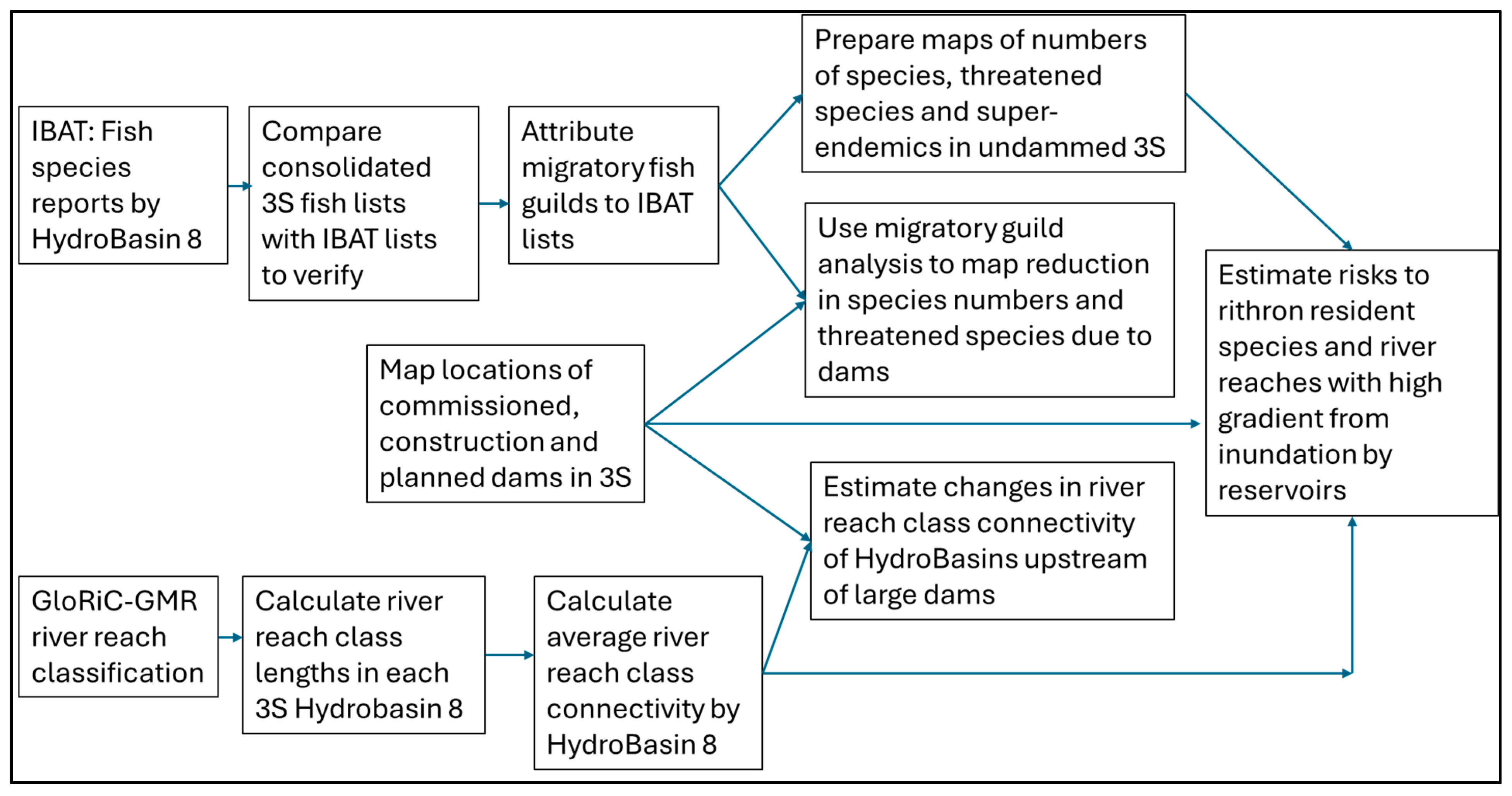
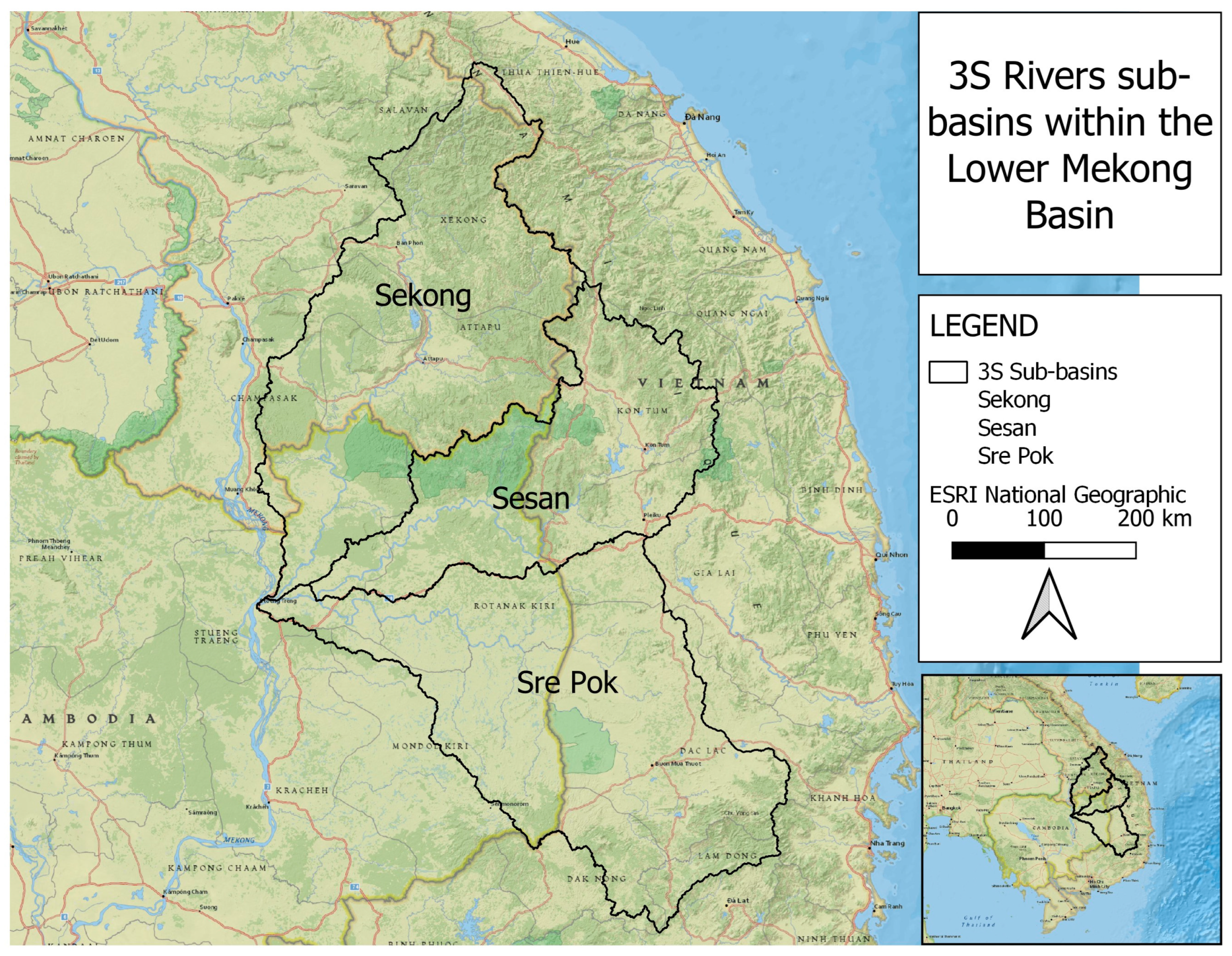
 ) on Sekong and major waterfalls (
) on Sekong and major waterfalls ( ). Adapted with permission from the Stimson Center [2].
). Adapted with permission from the Stimson Center [2].
 ) on Sekong and major waterfalls (
) on Sekong and major waterfalls ( ). Adapted with permission from the Stimson Center [2].
). Adapted with permission from the Stimson Center [2].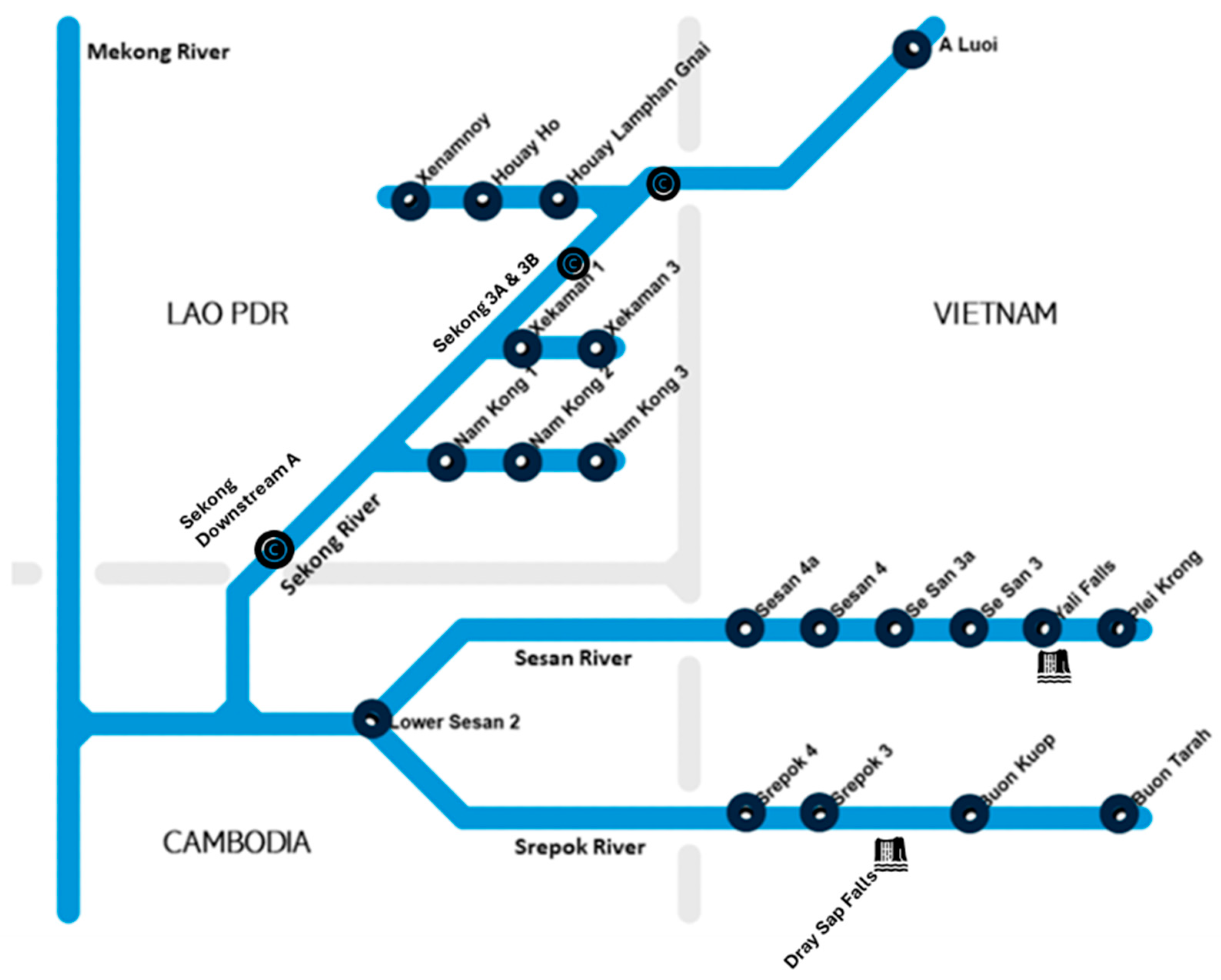
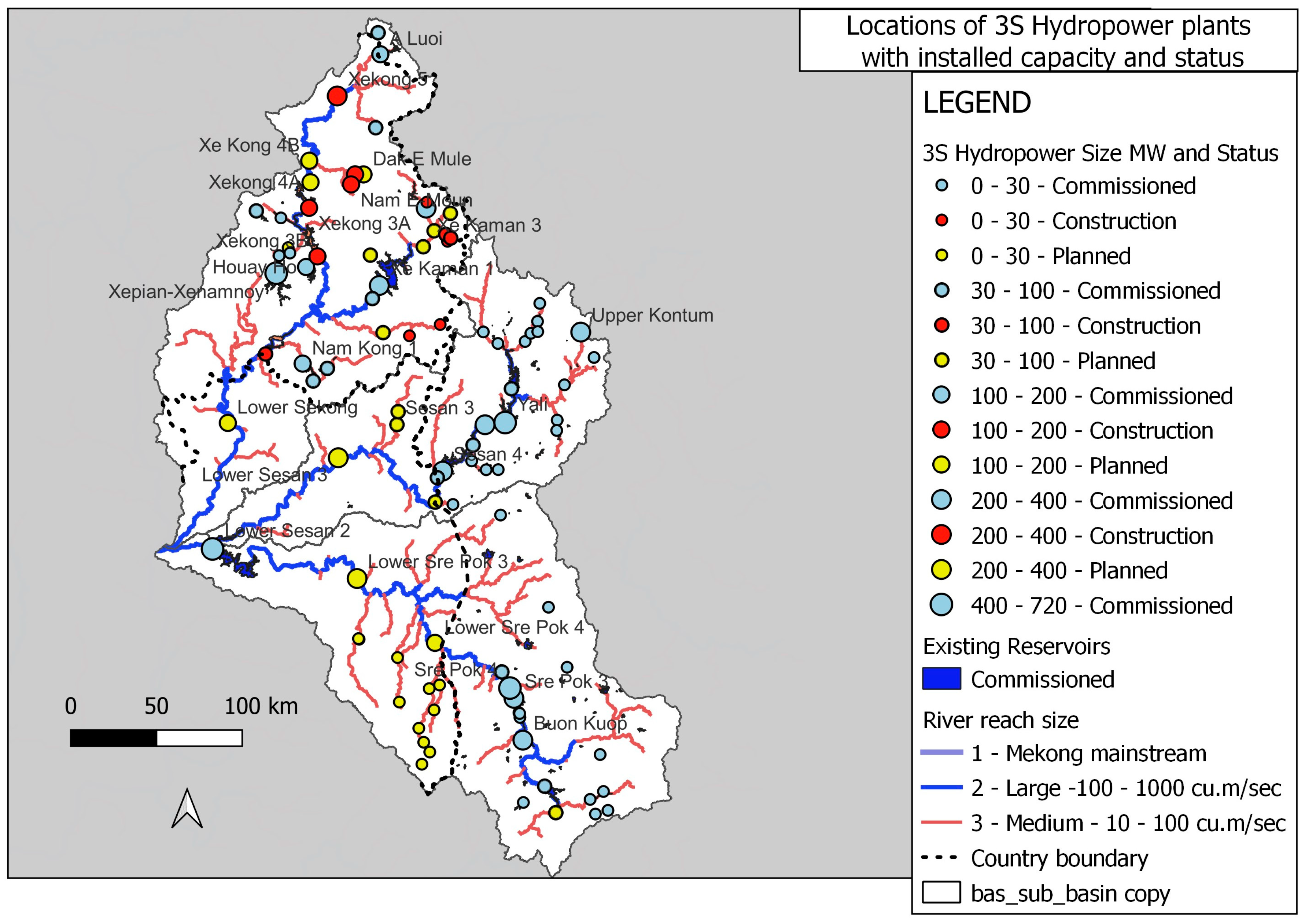

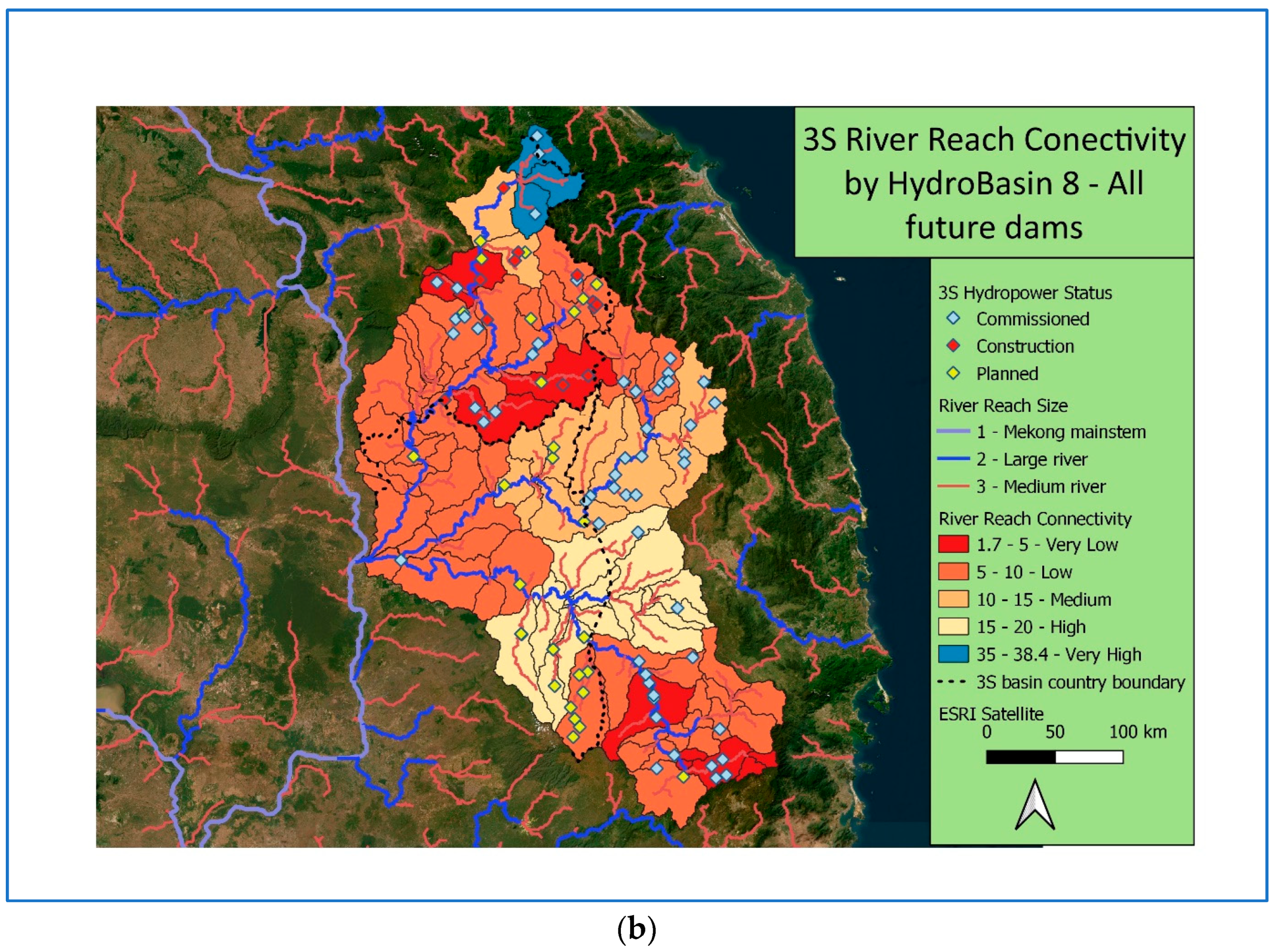


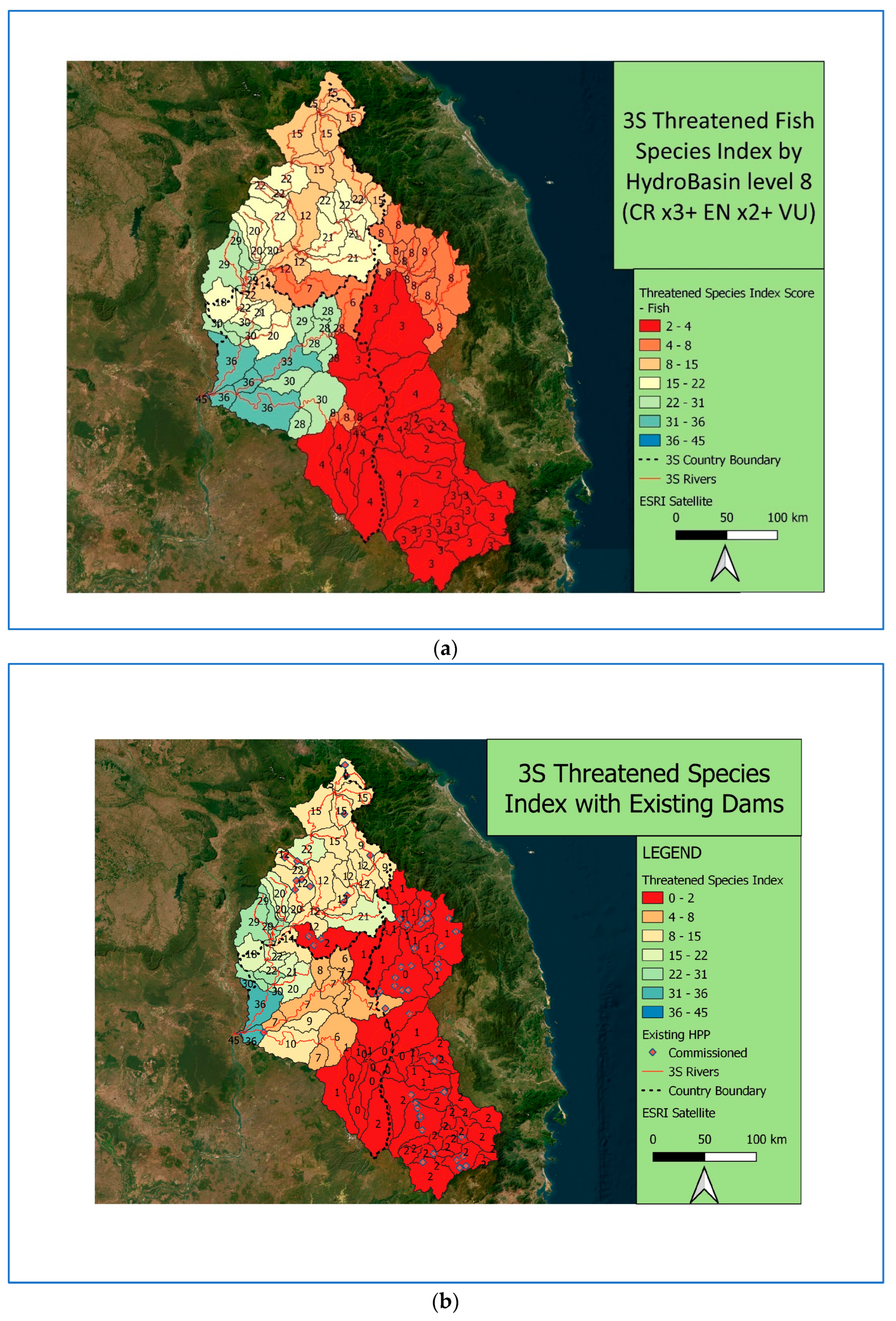
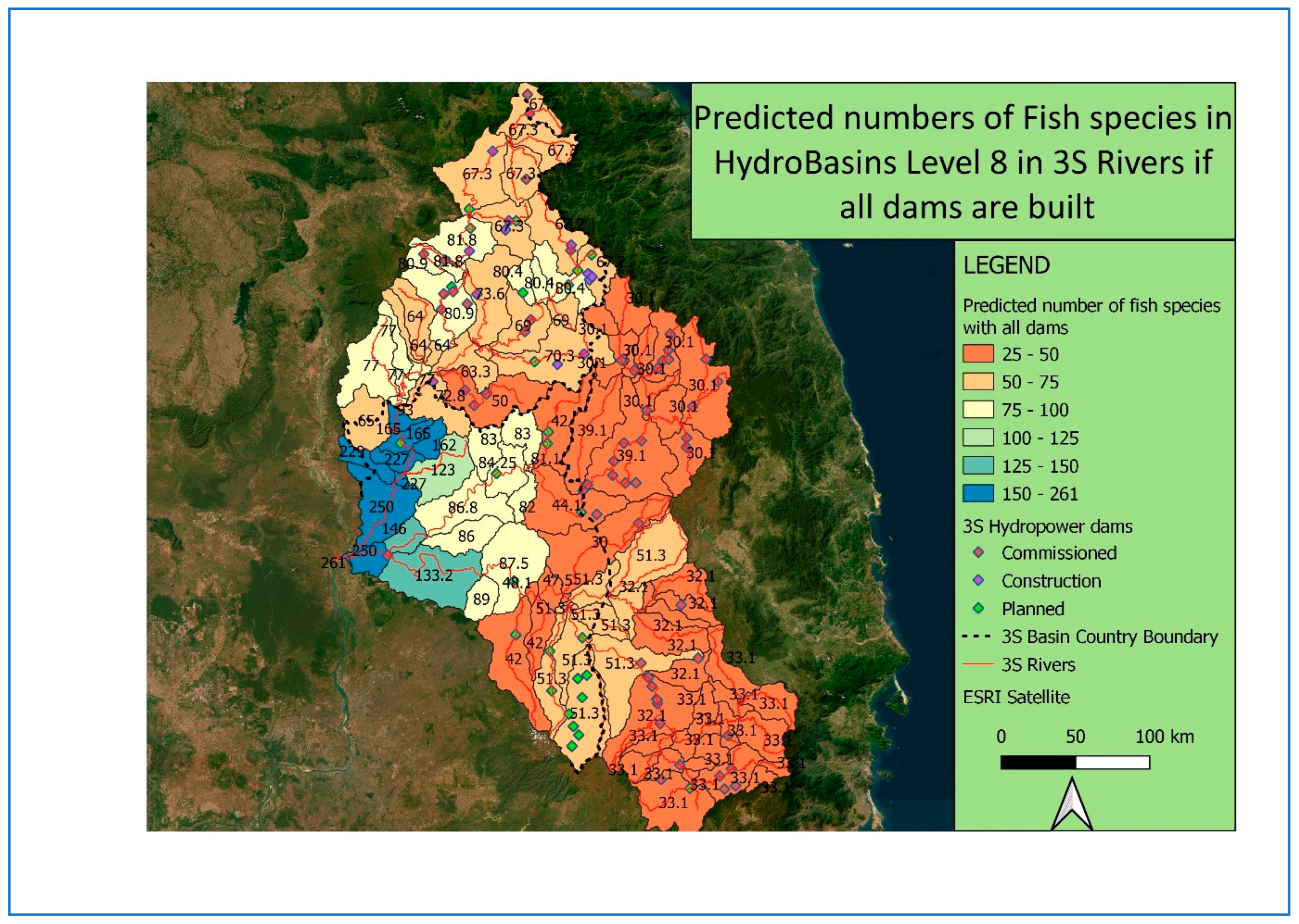

| Sub-Basin | Cambodia (km2) | Laos (km2) | Viet Nam (km2) | Total (km2) | Mainstem Length (km) | Total Stream Length (km) | No. of All Stream Orders | Mean Annual Flow (km3) |
|---|---|---|---|---|---|---|---|---|
| Sekong | 5565 | 22,565 | 690 | 28,820 | 425 | 4931 | 357 | 39.92 |
| Sesan | 7630 | - | 11,260 | 18,890 | 399 | 2784 | 253 | 27.2 |
| Sre Pok | 12,780 | - | 18,160 | 30,940 | 487 | 6729 | 626 | 23.57 |
| Total | 25,975 | 22,565 | 30,110 | 78,650 | 1311 | 14,444 | 1236 | 90.68 |
| Total % | 33% | 28.7% | 38.3% | 100% |
| Fish Guild | Impact of Dams on Migration | Dam Migration Impact Factor |
|---|---|---|
| 1. Rithron-resident guild | Little or no impact | 0 |
| 2. Migratory main channel and tributary-resident guild | Medium | 0.5 |
| 3. Migratory main channel spawner guild | Very high | 1 |
| 4. Migratory main channel refuge-seeker guild | Very high | 1 |
| 5. Generalist guild | Little or no impact | 0 |
| 6. Floodplain-resident guild (blackfish) | Little or no impact | 0 |
| 7. Estuarine resident guild | Little or no impact | 0 |
| 8. Semi-anadromous guild | High | 0.75 |
| 9. Catadromous guild | Very high | 1 |
| 10. Marine guild | Little or no impact | 0 |
| Commissioned | Under Construction | Planned | ||||
|---|---|---|---|---|---|---|
| Number | Installed Capacity | Number | Installed Capacity | Number | Installed Capacity | |
| MW | MW | MW | ||||
| Sekong | ||||||
| Large dams > 100 MW | 5 | 1272 | 5 | 624 | 5 | 950 |
| Medium dams—30–100 MW | 5 | 282 | 3 | 204 | 7 | 398 |
| Small dams < 30 MW | 4 | 57 | 3 | 36 | 2 | 35 |
| Sesan | ||||||
| Large dams > 100 MW | 7 | 2168 | 0 | 1 | 325 | |
| Medium dams—30–100 MW | 2 | 93 | 0 | 1 | 96 | |
| Small dams < 30 MW | 17 | 174 | 0 | 2 | 60 | |
| Sre Pok | ||||||
| Large dams > 100 MW | 2 | 500 | 0 | 2 | 443 | |
| Medium dams—30–100 MW | 4 | 260 | 0 | 1 | 49 | |
| Small dams < 30 MW | 10 | 138 | 0 | 10 | 72 | |
| 56 | 11 | 30 | ||||
| Installed Capacity | Reservoir Area | Active Storage | |
|---|---|---|---|
| MW | Ha | M cu.m | |
| Sekong | |||
| Total Commissioned + under construction | 2475 | 42,471 | 4.232 |
| Future Total | 3858 | 67,136 | 4.232 |
| Sesan | |||
| Total Commissioned + under construction | 2435 | 34,545 | 2.695 |
| Future Total | 2916 | 76,311 | 2.695 |
| Sre Pok | |||
| Total Commissioned + under construction | 897.5 | 6798 | 0.61 |
| Future Total | 1462 | 115,677 | 0.61 |
| Total for 3S basin | 8236 | 259,124 | 7.537 |
| Number of Species | ||||
|---|---|---|---|---|
| 3S Rivers | Sekong | Sesan | Sre Pok | |
| Total number of species in 3S | 331 | 316 | 287 | 282 |
| % of total | 95.47 | 86.71 | 85.20 | |
| Red List status | ||||
| CR—Critically Endangered | 7 | 7 | 7 | 6 |
| EN—endangered | 14 | 12 | 8 | 8 |
| VU—vulnerable | 16 | 15 | 15 | 13 |
| NT—Near Threatened | 8 | 8 | 7 | 7 |
| LC—Least Concern | 237 | |||
| DD—Data Deficient | 50 | |||
| Origin | ||||
| Super-endemics—11 | 29 | 22 | 9 | 3 |
| Endemics—1 | 61 | 59 | 52 | 52 |
| Indigenous—2 | 240 | 233 | 240 | 226 |
| Non-native—3 | 2 | 2 | 1 | 1 |
| Migratory guilds | ||||
| 1. Rithron-resident guild | 64 | 56 | 39 | 37 |
| 2. Migratory main channel and tributary)-resident guild | 18 | 18 | 16 | 16 |
| 3. Migratory main channel spawner guild | 59 | 58 | 57 | 56 |
| 4. Migratory main channel refuge-seeker guild | 55 | 55 | 55 | 55 |
| 5. Generalist guild | 86 | 83 | 80 | 78 |
| 6. Floodplain-resident guild (blackfish) | 28 | 26 | 24 | 24 |
| 7. Estuarine-resident guild | 10 | 9 | 9 | 8 |
| 8. Semi-anadromous guild | 7 | 7 | 5 | 5 |
| 9. Catadromous guild | 2 | 2 | 1 | 1 |
| 10. Marine guild | 2 | 2 | 1 | 1 |
Disclaimer/Publisher’s Note: The statements, opinions and data contained in all publications are solely those of the individual author(s) and contributor(s) and not of MDPI and/or the editor(s). MDPI and/or the editor(s) disclaim responsibility for any injury to people or property resulting from any ideas, methods, instructions or products referred to in the content. |
© 2024 by the authors. Licensee MDPI, Basel, Switzerland. This article is an open access article distributed under the terms and conditions of the Creative Commons Attribution (CC BY) license (https://creativecommons.org/licenses/by/4.0/).
Share and Cite
Meynell, P.-J.; Metzger, M.J.; Stuart, N. Assessing the Impacts of Changing Connectivity of Hydropower Dams on the Distribution of Fish Species in the 3S Rivers, a Tributary of the Lower Mekong. Water 2024, 16, 1505. https://doi.org/10.3390/w16111505
Meynell P-J, Metzger MJ, Stuart N. Assessing the Impacts of Changing Connectivity of Hydropower Dams on the Distribution of Fish Species in the 3S Rivers, a Tributary of the Lower Mekong. Water. 2024; 16(11):1505. https://doi.org/10.3390/w16111505
Chicago/Turabian StyleMeynell, Peter-John, Marc J. Metzger, and Neil Stuart. 2024. "Assessing the Impacts of Changing Connectivity of Hydropower Dams on the Distribution of Fish Species in the 3S Rivers, a Tributary of the Lower Mekong" Water 16, no. 11: 1505. https://doi.org/10.3390/w16111505
APA StyleMeynell, P.-J., Metzger, M. J., & Stuart, N. (2024). Assessing the Impacts of Changing Connectivity of Hydropower Dams on the Distribution of Fish Species in the 3S Rivers, a Tributary of the Lower Mekong. Water, 16(11), 1505. https://doi.org/10.3390/w16111505







